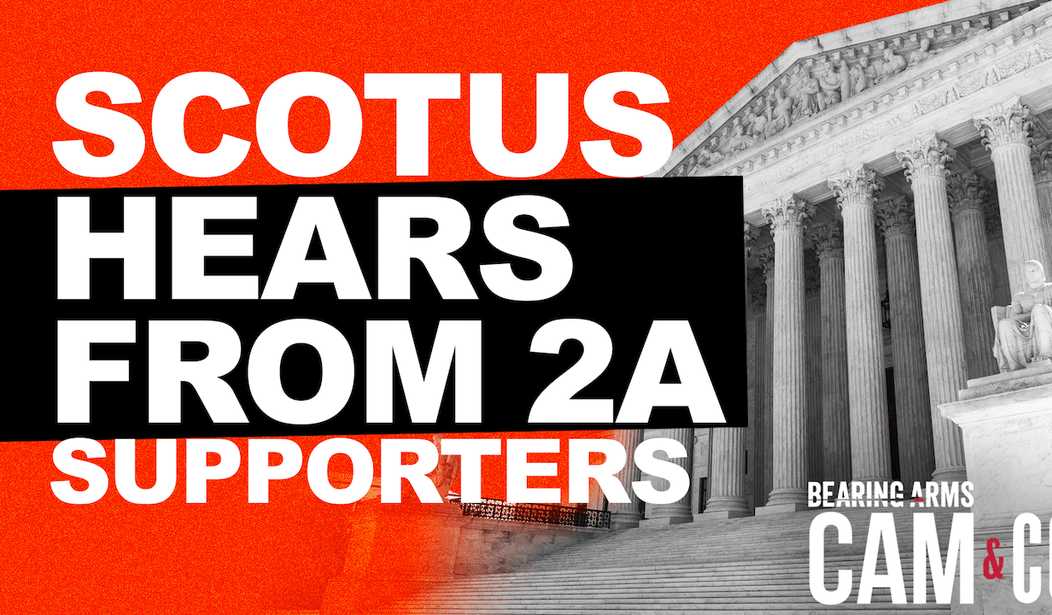There’s so much interest in the Supreme Court case dealing with New York’s carry laws that it could end up being the most-briefed case in Court history, according to the Second Amendment Foundation’s Alan Gottlieb. The founder and executive director of the 2A group joins me on today’s Bearing Arms’ Cam & Co to discuss a pair of those amicus briefs that have been filed this week; the briefs by the Second Amendment Foundation and its sister organization, the Citizens Committee for the Right to Keep and Bear Arms (where, in full disclosure, I serve as an unpaid board member).
Gottlieb says he’s feeling pretty confident about the Supreme Court striking down the New York law that requires residents to demonstrate a justifiable need to carry a firearm before they can receive a permit allowing them to possess a concealed handgun. Open carrying of firearms is banned outright under state law, which means that the average citizen is simply unable to exercise their right to bear arms in self-defense.
That, in turn, should lead a majority of the Court to find New York’s law unconstitutional, though Gottlieb says he’s not sure how sweeping of a decision we should expect from the majority. Will the Court begin to address broader issues like the standard of review in Second Amendment cases, or will a decision bypass those questions with a narrow focus on the New York law at hand?
We may have a better idea after oral arguments in NYSPRA v. Bruen are held this fall, but for the moment opponents of the law are making their own arguments to the Court in the form of these amicus briefs. In the brief submitted by SAF, the focus is on the historical aspects of the right to bear arms, which date back to the pre-Founding era and have continued on ever since.
From Independence through the end of the Civil War, no State imposed a broad ban prohibiting the carrying of firearms in any manner—with the exception of two nineteenth-century laws in Georgia and Tennessee that were partially struck down as inconsistent with the right to bear arms. By the time of the Second Amendment’s ratification, ten States do not appear to have enacted statutory restrictions on the public carrying of firearms by law-abiding citizens at all—and the remaining three merely imposed Americanized versions of the English Statute of Northampton, which (as in England) were understood to restrict only the carrying of firearms for a malicious purpose or in a particularly terrorizing manner.
While some have attempted to read these statutes as a general ban on carrying firearms in public, the text of these statutes and the historical record conclusively refute that revisionist interpretation. Indeed, the many Founders—including the first six Presidents—who routinely carried arms outside the home would surely have been surprised to learn that doing so made them all habitual criminals.
The entire brief offers a fantastic history lesson for those who want to learn more about the Second Amendment in the early days of the Republic. The brief from the Citizens Committee for the Right to Keep and Bear Arms, on the other hand, argues that the right to keep and bear arms is needed because the veneer of civilization is thin, and our right of self-defense depends on our ability to exercise our Second Amendment rights as well.
The Founders comprehended from their observation of colonial life—and their understanding of mankind— that the veneer of civilization is thin. They reflected openly in The Federalist papers about man’s inherent tendencies toward conflict and violence. Indeed, a central project at the founding was organizing a government that preserved liberty while checking some of these tendencies. But they understood that government could not change human nature, so flareups of violence and chaos would be inevitable, particularly in a system of dual sovereignty; thus the Second Amendment’s preservation of the pre-existing right to keep and bear arms.
The fragility of civilization is on full display in America today. Violent riots erupted throughout the Nation in 2020, and violence has remained elevated as police—already strained and now under political assault—have retreated in major cities. Just as in periods of social and political unrest and conflict in prior centuries, a surge in violent crime has followed the breakdown of social order.
These trends are only being exacerbated as a political movement has, in some jurisdictions, targeted traditional law enforcement institutions with radical policies. Movements to “defund” the police have had predictably violent results. Meanwhile, prosecutors in some of these same jurisdictions announce that they simply are not going to enforce many criminal laws. The downward spiral is accelerating as police officers and prosecutors, appalled at the attacks on their roles, are leaving their jobs in droves.
The American people understand what is happening. They understand that they are responsible for their self-defense, so more of them are arming themselves in response to these conditions. This is an especially important time for the Court to re-affirm that the Second Amendment protects their right to carry firearms for their self-defense.
There’s no question that demand for firearms is at an historic level at the moment, and many Americans want to be able to not only keep a gun in the home for protection, but to carry one with them as well. In the vast majority of states, that’s doable for the vast majority of people. In New York, on the other hand, you’ve gotta be special before you can exercise your rights. That’s just wrong, and now it’s up to the Supreme Court to set the state straight.
You can check out all of the amicus briefs received by the Supreme Court here, and we’ll be sharing highlights from some of the many excellent arguments against New York’s gun control law in the coming days.








Join the conversation as a VIP Member